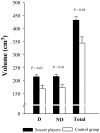Soccer attenuates the asymmetry of rectus abdominis muscle observed in non-athletes
- PMID: 21541351
- PMCID: PMC3081838
- DOI: 10.1371/journal.pone.0019022
Soccer attenuates the asymmetry of rectus abdominis muscle observed in non-athletes
Abstract
Purpose: To determine the volume and degree of asymmetry of the rectus abdominis muscle (RA) in professional soccer players.
Methods: The volume of the RA was determined using magnetic resonance imaging (MRI) in 15 professional male soccer players and 6 non-active male control subjects.
Results: Soccer players had 26% greater RA volume than controls (P<0.05), due to hypertrophy of both the dominant (28% greater volume, P<0.05) and non-dominant (25% greater volume, P<0.01) sides, after adjusting for age, length of the RA muscle and body mass index (BMI) as covariates. Total volume of the dominant side was similar to the contralateral in soccer players (P = 0.42) and in controls (P = 0.75) (Dominant/non-dominant = 0.99, in both groups). Segmental analysis showed a progressive increase in the degree of side-to-side asymmetry from the first lumbar disc to the pubic symphysis in soccer players (r = 0.80, P<0.05) and in controls (r = 0.75, P<0.05). The slope of the relationship was lower in soccer players, although this trend was not statistically significant (P = 0.14).
Conclusions: Professional soccer is associated with marked hypertrophy of the rectus abdominis muscle, which achieves a volume that is 26% greater than in non-active controls. Soccer induces the hypertrophy of the non-dominant side in proximal regions and the dominant side in regions closer to pubic symphysis, which attenuates the pattern of asymmetry of rectus abdominis observed in non-active population. It remains to be determined whether the hypertrophy of rectus abdominis in soccer players modifies the risk of injury.
Conflict of interest statement
Figures





References
-
- Rahnama N, Lees A, Bambaecichi E. Comparison of muscle strength and flexibility between the preferred and non-preferred leg in English soccer players. Ergonomics. 2005;48:1568–1575. - PubMed
-
- Raty HP, Kujala U, Videman T, Koskinen SK, Karppi SL, et al. Associations of isometric and isoinertial trunk muscle strength measurements and lumbar paraspinal muscle cross-sectional areas. J Spinal Disord. 1999;12:266–270. - PubMed
-
- Hides J, Fan T, Stanton W, Stanton P, McMahon K, et al. Psoas and quadratus lumborum muscle asymmetry among elite Australian Football League players. Br J Sports Med. 2010;44:563–567. - PubMed
-
- Masuda K, Kikuhara N, Takahashi H, Yamanaka K. The relationship between muscle cross-sectional area and strength in various isokinetic movements among soccer players. J Sports Sci. 2003;21:851–858. - PubMed
-
- Stewart S, Stanton W, Wilson S, Hides J. Consistency in size and asymmetry of the psoas major muscle among elite footballers. Br J Sports Med. 2010;44:1173–1177. - PubMed
Publication types
MeSH terms
LinkOut - more resources
Full Text Sources

